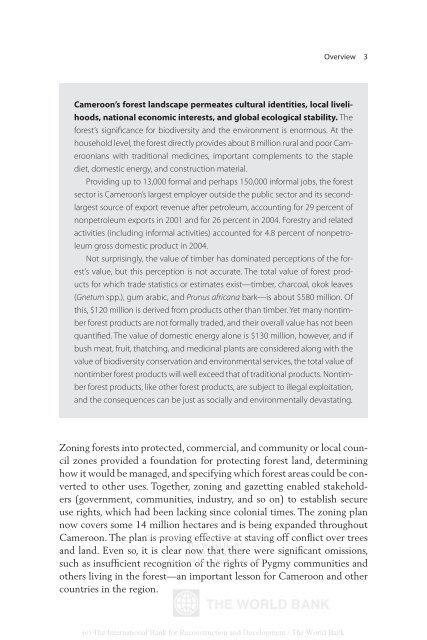The Rainforests of Cameroon - PROFOR
The Rainforests of Cameroon - PROFOR
The Rainforests of Cameroon - PROFOR
- No tags were found...
You also want an ePaper? Increase the reach of your titles
YUMPU automatically turns print PDFs into web optimized ePapers that Google loves.
Overview 3<strong>Cameroon</strong>’s forest landscape permeates cultural identities, local livelihoods,national economic interests, and global ecological stability. <strong>The</strong>forest’s significance for biodiversity and the environment is enormous. At thehousehold level, the forest directly provides about 8 million rural and poor <strong>Cameroon</strong>ianswith traditional medicines, important complements to the staplediet, domestic energy, and construction material.Providing up to 13,000 formal and perhaps 150,000 informal jobs, the forestsector is <strong>Cameroon</strong>’s largest employer outside the public sector and its secondlargestsource <strong>of</strong> export revenue after petroleum, accounting for 29 percent <strong>of</strong>nonpetroleum exports in 2001 and for 26 percent in 2004. Forestry and relatedactivities (including informal activities) accounted for 4.8 percent <strong>of</strong> nonpetroleumgross domestic product in 2004.Not surprisingly, the value <strong>of</strong> timber has dominated perceptions <strong>of</strong> the forest’svalue, but this perception is not accurate. <strong>The</strong> total value <strong>of</strong> forest productsfor which trade statistics or estimates exist—timber, charcoal, okok leaves( Gnetum spp.), gum arabic, and Prunus africana bark—is about $580 million. Ofthis, $120 million is derived from products other than timber. Yet many nontimberforest products are not formally traded, and their overall value has not beenquantified. <strong>The</strong> value <strong>of</strong> domestic energy alone is $130 million, however, and ifbush meat, fruit, thatching, and medicinal plants are considered along with thevalue <strong>of</strong> biodiversity conservation and environmental services, the total value <strong>of</strong>nontimber forest products will well exceed that <strong>of</strong> traditional products. Nontimberforest products, like other forest products, are subject to illegal exploitation,and the consequences can be just as socially and environmentally devastating.Zoning forests into protected, commercial, and community or local councilzones provided a foundation for protecting forest land, determininghow it would be managed, and specifying which forest areas could be convertedto other uses. Together, zoning and gazetting enabled stakeholders(government, communities, industry, and so on) to establish secureuse rights, which had been lacking since colonial times. <strong>The</strong> zoning plannow covers some 14 million hectares and is being expanded throughout<strong>Cameroon</strong>. <strong>The</strong> plan Delivered is proving by <strong>The</strong> effective World Bank at e-library staving to: <strong>of</strong>f conflict over trees<strong>The</strong> World Bankand land. Even so, it is clear IP now : 192.86.100.34 that there were significant omissions,such as insufficient recognition Mon, 09 <strong>of</strong> Nov the 2009 rights 17:06:18 <strong>of</strong> Pygmy communities andothers living in the forest—an important lesson for <strong>Cameroon</strong> and othercountries in the region.(c) <strong>The</strong> International Bank for Reconstruction and Development / <strong>The</strong> World Bank
















